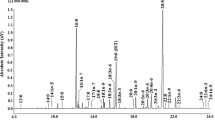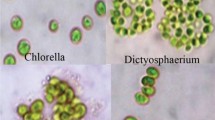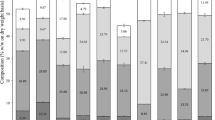Abstract
Polyunsaturated fatty acids are essential biomolecules to human health since their consumption is associated with decreased risk of cardiovascular, inflammatory and cancer diseases, for instance. Despite largely unexplored, sub-Antarctic macroalgae have a considerable nutraceutical potential since this region is known for its harsh environmental conditions, which forces macroalgae to produce secondary metabolites. Therefore, the aims of this work were to determine the fatty acid profile of Ulva sp., Lessonia flavicans Bory and Pyropia columbina (Montagne) W.A. Nelson collected from different collection sites in the Magellan region. Results showed that macroalgae were comprised of 18 to 24 fatty acids with generally a predominance of saturated fatty acids (SFAs) than unsaturated fatty acids. SFAs comprehended 34.40 ± 0.61 mol% of Lessonia flavicans while Pyropia columbina had 69.06 ± 0.77 mol% mainly in the form of palmitic acid. Polyunsaturated fatty acids were found in concentrations ranging from 15.80 ± 0.56 mol% in Pyropia columbina to 54.93 ± 0.15 in Lessonia flavicans. The nutraceutical potential of these macroalgae was observed as the samples had a ∑n3/∑n6 ratio above the indicated by the World Health Organization. Principal Component Analysis showed that the fatty acid profile is characteristic of each macroalgae being a biochemical marker for the identification of the organisms. Therefore, sub-Antarctic macroalgae comprise a promising renewable source of essential fatty acids, mainly as n3, that are essential to the maintenance of human health.


Similar content being viewed by others
References
Astorga-España MS, Mansilla A (2014) Sub-Antarctic macroalgae: opportunities for gastronomic tourism and local fisheries in the Region of Magallanes and Chilean Antarctic Territory. J Appl Phycol 26:973–978. https://doi.org/10.1007/s10811-013-0141-1
Becker S, Graeve M, Bischof K (2010) Photosynthesis and lipid composition of the Antarctic endemic rhodophyte Palmaria decipiens: effects of changing light and temperature levels. Polar Biol 33:945–955. https://doi.org/10.1007/s00300-010-0772-5
Belghit I, Rasinger JD, Heesch S et al (2017) In-depth metabolic profiling of marine macroalgae confirms strong biochemical differences between Rhodophyta, red and green algae. Algal Res 26:240–249. https://doi.org/10.1016/j.algal.2017.08.001
Berneira LM, da Silva C, Poletti T et al (2020) Evaluation of the volatile composition and fatty acid profile of seven Antarctic macroalgae. J Appl Phycol 32:3319–3329. https://doi.org/10.1007/s10811-020-02170-9
Berneira LM, da Silva CC, Passos LF et al (2021) Evaluation of volatile organic compounds in brown and red sub-Antarctic macroalgae. Braz. J. Bot. https://doi.org/10.1007/s40415-020-00684-7
Bligh EG, Dyer WJ (1959) A rapid method of total lipid extraction and purification. Can J Biochem Physiol 37:911–917
Cian RE, Fajardo MA, Alaiz M et al (2014) Chemical composition, nutritional and antioxidant properties of the red edible seaweed Porphyra columbina. Int J Food Sci Nutr 65:299–305. https://doi.org/10.3109/09637486.2013.854746
Cian RE, Bacchetta C, Rossi A et al (2019) Red seaweed Pyropia columbina as antioxidant supplement in feed for cultured juvenile Pacú (Piaractus mesopotamicus). J Appl Phycol 31:1455–1465. https://doi.org/10.1007/s10811-018-1648-2
de Freitas SC, Berneira LM, dos Santos MAZ et al (2020) Bioactivity evaluation and composition of extracts from sub-Antarctic macroalgae Mazzaella laminarioides at distinct development phases. Braz J Bot 43:689–696. https://doi.org/10.1007/s40415-020-00661-0
dos Santos MAZ, de Freitas SC, Berneira LM et al (2019) Pigment concentration, photosynthetic performance, and fatty acid profile of sub-Antarctic brown macroalgae in different phases of development from the Magellan Region, Chile. J Appl Phycol 31:2629–2642. https://doi.org/10.1007/s10811-019-01777-x
Elagizi A, Lavie CJ, Marshall K et al (2018) Omega-3 polyunsaturated fatty acids and cardiovascular health: a comprehensive review. Prog Cardiovasc Dis. https://doi.org/10.1016/j.pcad.2018.03.006
Folch J, Lees M, Stanley GHS (1957) A simple method for the isolation and purification of total lipides from animal tissues. J Biol Chem 226:497–509
Kumari P, Kumar M, Gupta V et al (2010) Tropical marine macroalgae as potential sources of nutritionally important PUFAs. Food Chem 120:749–757. https://doi.org/10.1016/j.foodchem.2009.11.006
Mansilla A, Rosenfeld S, Rendoll J et al (2014) Tolerance response of Lessonia flavicans from the sub-Antarctic ecoregion of Magallanes under controlled environmental conditions. J Appl Phycol 26:1971–1977. https://doi.org/10.1007/s10811-014-0294-6
McCauley JI, Meyer BJ, Winberg PC, Skropeta D (2016) Parameters affecting the analytical profile of fatty acids in the macroalgal genus Ulva. Food Chem 209:332–340. https://doi.org/10.1016/j.foodchem.2016.04.039
Martins RM, Nedel F, Guimarães VBS et al (2018) Macroalgae extracts from Antarctica have antimicrobial and anticancer potential. Front Microbiol 9:1–10. https://doi.org/10.3389/fmicb.2018.00412
Martins RM, dos Santos MAZ, Pacheco BS et al (2016) Fatty acid profile of the chlorophyta species from Chile’s sub-Antarctic region. Acad J Sci Res 4:93–98. https://doi.org/10.15413/ajsr.2015.0154
Moss CW, Lambert MA, Merwin WH (1974) Comparison of rapid methods for analysis of bacterial fatty acids. Appl Microbiol 28:80–85
Passos LF, Berneira LM, Poletti T et al (2020) Evaluation and characterization of algal biomass applied to the development of fingermarks on glass surfaces. Aust J Forensic Sci. https://doi.org/10.1080/00450618.2020.1715478
Pereira H, Polo C, Rešek E, Engelen A (2012) Polyunsaturated fatty acids of marine macroalgae: potential for nutritional and pharmaceutical applications. Mar Drugs 10:1920–1935. https://doi.org/10.3390/md10091920
Ragonese C, Tedone L, Beccaria M et al (2014) Characterisation of lipid fraction of marine macroalgae by means of chromatography techniques coupled to mass spectrometry. Food Chem 145:932–940. https://doi.org/10.1016/j.foodchem.2013.08.130
Rodrigues D, Freitas AC, Pereira L et al (2015) Chemical composition of red, brown and green macroalgae from Buarcos bay in Central West Coast of Portugal. Food Chem 183:197–207. https://doi.org/10.1016/j.foodchem.2015.03.057
Saini RK, Keum Y (2018) Omega-3 and omega-6 polyunsaturated fatty acids: dietary sources, metabolism, and significance—a review. Life Sci. https://doi.org/10.1016/j.lfs.2018.04.049
Santos MAZ, Colepicolo P, Pupo D et al (2017) Antarctic red macroalgae: a source of polyunsaturated fatty acids. J Appl Phycol 29:759–767. https://doi.org/10.1007/s10811-016-1034-x
Schmid M, Guihéneuf F, Stengel DB (2016) Evaluation of food grade solvents for lipid extraction and impact of storage temperature on fatty acid composition of edible seaweeds Laminaria digitata (Phaeophyceae) and Palmaria palmata (Rhodophyta). Food Chem 208:161–168. https://doi.org/10.1016/j.foodchem.2016.03.123
Schmid M, Kraft LGK, Van Der LL et al (2018) Southern Australian seaweeds: a promising resource for omega-3 fatty acids. Food Chem. https://doi.org/10.1016/j.foodchem.2018.05.060
Shanab SMM, Hafez RM, Fouad AS (2018) A review on algae and plants as potential source of Arachidonic acid. J Adv Res. https://doi.org/10.1016/j.jare.2018.03.004
Silva G, Pereira RB, Valentão P et al (2013) Distinct fatty acid profile of ten brown macroalgae. Braz J Pharmacogn 23:608–613. https://doi.org/10.1590/S0102-695X2013005000048
Simopoulos AP (2008) The importance of the omega-6/omega-3 fatty acid ratio in cardiovascular disease and other chronic diseases artemis. Exp Biol Med 233:674–688. https://doi.org/10.3181/0711-MR-311
Sudhakar K, Mamat R, Samykano M et al (2018) An overview of marine macroalgae as bioresource. Renew Sustain Energy Rev 91:165–179. https://doi.org/10.1016/j.rser.2018.03.100
Acknowledgements
The authors are thankful for the financial and fellowship support from the Brazilian research funding agencies National Council for Scientific and Technological Development (CNPq), Coordination for Improvement of Higher Level Personnel (CAPES) and Foundation for Research Support of the State of Rio Grande do Sul (FAPERGS).
Author information
Authors and Affiliations
Contributions
MAZdS was involved in conceptualization. NLG was involved in methodology. LMB was involved in writing—original draft preparation. AM was involved in writing—review and editing. CMPdP was involved in funding acquisition. MSAE arranged resources.
Corresponding author
Ethics declarations
Conflict of interest
The authors declare no conflict of interest.
Additional information
Publisher's Note
Springer Nature remains neutral with regard to jurisdictional claims in published maps and institutional affiliations.
Supplementary Information
Below is the link to the electronic supplementary material.
Rights and permissions
About this article
Cite this article
dos Santos, M.A.Z., Berneira, L.M., Goulart, N.L. et al. Rhodophyta, Ochrophyta and Chlorophyta macroalgae from different sub-Antarctic regions (Chile) and their potential for polyunsaturated fatty acids. Braz. J. Bot 44, 429–438 (2021). https://doi.org/10.1007/s40415-021-00712-0
Received:
Revised:
Accepted:
Published:
Issue Date:
DOI: https://doi.org/10.1007/s40415-021-00712-0




